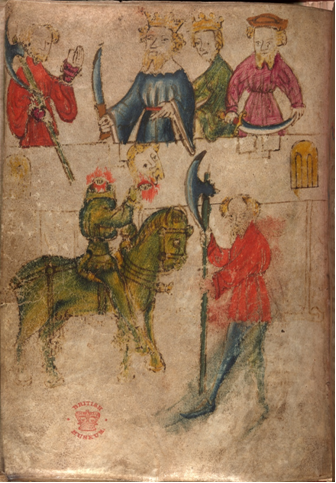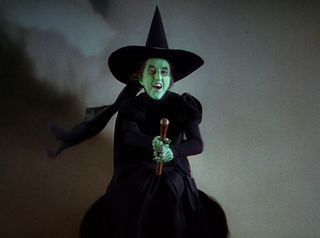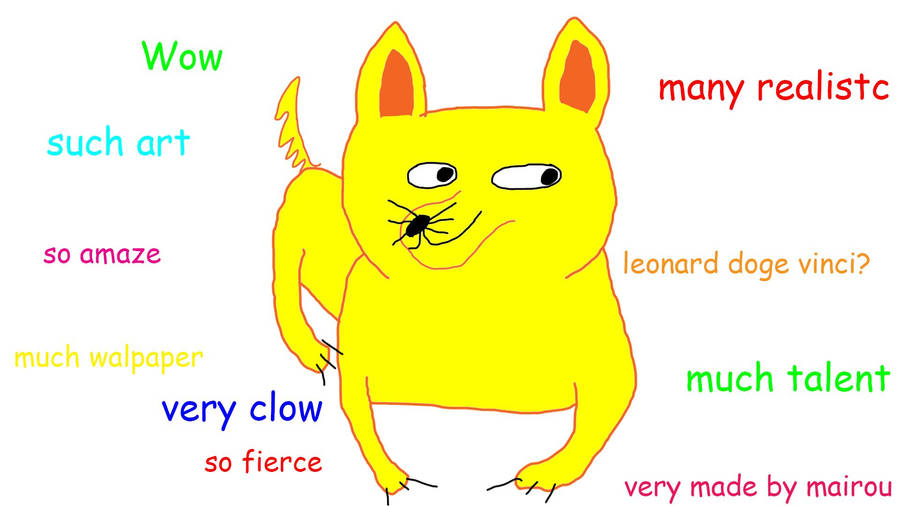[This post, part of an effort to merge our undergraduate and graduate blogs, was written in response to an essay prompt for Kathryn Kerby-Fulton's undergraduate course on "Chaucer's Biggest Rivals: The Alliterative Poets." It comes from the former "Medieval Undergraduate Research" website.]
Sir Gawain and the Green Knight
Lines 279-300
“Nay, frayst I no fyȝt, in fayth I þe telle;
Hit arn aboute on þis bench bot berdlez chylder.
If I were hasped in armes on a heȝe stede,
Here is no mon me to mach, for myȝtez so wayke.
Forþy I craue in þis court a Crystemas gomen,
For hit is Ȝol and Nwe Ȝer, and here ar ȝep mony.
If any so hardy in þis hous holdez hymseluen,
Be so bolde in his blod, brayn in hys hede,
Þat dar stifly strike a strok for anoþer,
I schal gif hym of my gyft þys giserne ryche,
Þis ax, þat is heué innogh, to hondele as hym lykes,
And I schal bide þe fyrst bur as bare as I sitte.
If any freke be so felle to fonde þat I telle,
Lepe lyȝtly me to, and lach þis weppen–
I quit-clayme hit for euer, kepe hit as his auen–
And I schal stonde hym a strok, stif on þis flet,
Ellez þou wyl diȝt me þe dom to dele hym an oþer
Barlay,
And ȝet gif hym respite,
A twelmonyth and a day.
Now hyȝe, and let se tite
Dar any herinne oȝt say.”
My Translation:
“Nay, I do not seek to fight, in truth I tell you;
There are about on these benches only beardless children.
Were I in full arms on a high steed,
There is nobody here to match me, for their powers are so weak.
Therefore, I ask for a Christmas game in this court,
For it is Yule and New Year, and there are many brisk youths.
If anyone in this house considers himself so bold,
Be so bold in his blood, so mad in his head,
That dares to fearlessly exchange one strike for another,
I shall give him as my gift this battle axe,
This ax, that is heavy enough, to handle as he likes,
And I shall bide the first blow as I sit without armor.
If any man be so bold as to try what I propose,
Leap swiftly to me, and grab hold of this weapon,
I renounce it forever, let him keep it as his own,
And I shall stand and take a stroke from him, unflinching on the floor,
Provided that he will give me the right to deal him another
In my turn,
And yet give him respite,
Twelve months and a day.
Now hasten, and let me quickly see
If anyone dare to take up the game.”

King Arthur’s laughter danced through his great hall, infusing all the knights and ladies with such mirth, before a giant of a green man and his steed burst through the doors. He wore neither a helmet nor hauberk, and his gaze was so lightning sharp it seemed as if no man could survive his glances. This Green Knight then began to speak: “The praise of you, prince, is puffed up so high, / And your court and your company are counted the best” (Borroff 258-9). He proceeds by presenting a challenge to King Arthur’s Round Table, asking not for a fight, but rather for a game in order to test Camelot’s powerful reputation. This passage in which the Green Knight dares any man bold enough to enter his game serves as a prime example of the author’s talented use of consonance and alliteration as well as warlike imagery to sculpt his poem.
Each alliterative line in this passage contains the repetition of a consonant. Prefacing his proposal, the Green Knight says, “frayst I no fyȝt, in fayth I þe telle” (279), which translates to “to fight, in good faith, is far from my thought” (Borroff 279). The combination of consonance and alliteration works not only to highlight the statement but also to give the knight a strong, almost harsh tone with the “f” repetition. His tone is established in other lines as well: “Here is no mon me to mach, for myȝtez so wayke” (282), the Green Knight claims, meaning, “For measured against mine, their might is puny.” Every “m” word, each repetition, gives rise to the opportunity to re-emphasize the power of the Green Knight over the court of Camelot at this moment due to his superior “myȝtez.” When he explains how the game works, how whoever comes forward will strike at him with his axe, the knight again talks of his strength of character: “And I schal stonde hym a strok, stif on þis flet” (294), which translates as, “And I shall stand him a stroke, steady on this floor.” Essentially, by focusing on the lines within this passage that feature alliteration and consonance, a better understanding of the Green Knight as a very strong and very confident character emerges.
In addition, this passage contains engaging warlike imagery that helps to create a picture in the reader’s mind of how sharply the Green Knight’s savage game contrasts with the youthful mirth of King Arthur’s court. Take, for instance, how the knight calls the people of the court “beardless children” (280). These gentlemen and ladies are meant to stand as examples of the true greatness of the realm; yet within moments the Green Knight bluntly dismisses them as frivolous children who do not possess the strength or the boldness to defend Camelot. Another example are the lines: “If any so hardy in þis hous holdez hymseluen, / Be so bolde in his blod, brayn in hys hede, / Þat dar stifly strike a strok for an oþer” (285-7), or, “If any in this house such hardihood claims, / Be so bold in his blood, his brain so wild, / As stoutly to strike one stroke for another.” Here, the knight further describes the sense of daring and courage necessary for a man to enter the game, and he does so in such a way as to inspire an image of a man like himself, an almost-giant who boldly ventures into his enemy’s territory without armor. Readers can then call upon the prolific descriptions of the Green Knight and his horse earlier in the poem to enhance the imagery of both the confrontation between the knight and the court as well as the kind of knight who will step forward to take up the axe. These two examples serve to underscore how the author of the poem skillfully selects words that together paint a visual picture of the court, its people, the Green Knight, and the perfect knight who will accept the challenge.
The above English translations of the poem come from Marie Borroff, a renowned poetic translator. In the introduction to her translation, she writes, “I have done my best during the entire process of translation to attend carefully and respectfully to the exact sense of the poem at every turn, though I have inevitably had at times to decide what was essential in a given line” (Borroff xiii). Despite even Borroff’s best efforts, disagreements over her choices exist. For instance, she translates “myȝtez” (282) as “might” where I chose “powers” in my translation. By using “might,” Borroff maintains the consonant alliteration, but I decided on “powers” because I wanted to refer to the idea of an overarching power game between good and evil throughout the poem. “Might” did not convey that same meaning in my opinion. Another example is the word “hardy” (285), which Borroff and I translate as “bold.” Even though she and I both ultimately chose “bold,” it is important to highlight the other potential translations of the word “hardy”: brave, harsh, stubborn, oppressive, and violent. Each of these describes the Green Knight more than his future opponent, Gawain; yet perhaps these words describe what Gawain might become during and after the challenge. Overall, Borroff provides a solid translation of this passage, though in some cases, the layers of meanings are lost along with the stylistic devices.
The Green Knight fearlessly throws down the gauntlet before King Arthur and his knights of the Round Table. Through the alliteration of consonants, the warlike imagery, and the word choices in the poem and its translation, the knight stands as an indomitable force that tests the seemingly superior reputation of Camelot.
Shannon Bugos
University of Notre Dame





